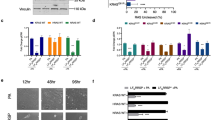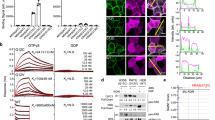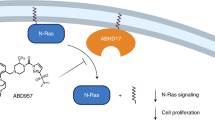Abstract
The ability of Ras oncoproteins to cause malignant transformation requires their post-translational modifications by prenyl groups. Because K-Ras can be both farnesylated and geranylgeranylated it is not known whether both farnesyltransferase and geranylgeranyltransferase I inhibitors are required for suppressing human tumor growth in whole animals. In this paper we report that oncogenic Ras processing, MAP kinase activation and growth in nude mice are inhibited by the farnesyltransferase inhibitor FTI-276 in H- and N-Ras transformed NIH3T3 cells; whereas in KB-Ras transformed NIH3T3 cells both FTI-276 and the geranylgeranyltransferase I inhibitor GGTI-297 are required for inhibition. Furthermore, human lung A-549 and Calu-1 carcinoma cell lines were found to co-express H-, N- and K-Ras. In Calu-1 cells, the processing of H- and N-Ras is inhibited greatly by FTI-276 but only partially by GGTI-297 whereas K-Ras processing inhibition requires both FTI-276 and GGTI-297. In contrast, in A-549 cells the processing of H- and N-Ras is inhibited only by FTI-276 and K-Ras processing is resistant to co-treatment with FTI-276 and GGTI-297. Yet, the growth in nude mice of A-549 and Calu-1 xenografts, both of which express K-Ras mutations, is inhibited by FTI-276 (80% inhibition) and GGTI-297 (60%). Furthermore, FTI-276 inhibits tumor growth of NIH3T3 cells transformed by a form of oncogenic H-Ras that is exclusively geranylgeranylated and whose processing is resistant to this inhibitor. Taken together, the results demonstrate that both FTase and GGTase I inhibitors are required for inhibition of K-Ras processing but that each alone is sufficient to suppress human tumor growth in nude mice.
This is a preview of subscription content, access via your institution
Access options
Subscribe to this journal
Receive 50 print issues and online access
$259.00 per year
only $5.18 per issue
Buy this article
- Purchase on Springer Link
- Instant access to full article PDF
Prices may be subject to local taxes which are calculated during checkout
Similar content being viewed by others
Author information
Authors and Affiliations
Rights and permissions
About this article
Cite this article
Sun, J., Qian, Y., Hamilton, A. et al. Both farnesyltransferase and geranylgeranyltransferase I inhibitors are required for inhibition of oncogenic K-Ras prenylation but each alone is sufficient to suppress human tumor growth in nude mouse xenografts. Oncogene 16, 1467–1473 (1998). https://doi.org/10.1038/sj.onc.1201656
Received:
Revised:
Accepted:
Published:
Issue Date:
DOI: https://doi.org/10.1038/sj.onc.1201656
Keywords
This article is cited by
-
Mesenchymal subtype neuroblastomas are addicted to TGF-βR2/HMGCR-driven protein geranylgeranylation
Scientific Reports (2020)
-
Developing consensus 3D-QSAR and pharmacophore models for several beta-secretase, farnesyl transferase and histone deacetylase inhibitors
Journal of Molecular Modeling (2012)
-
Protein farnesylation and disease
Journal of Inherited Metabolic Disease (2012)
-
Geranylgeranyl Diphosphate Synthase: An Emerging Therapeutic Target
Clinical Pharmacology & Therapeutics (2011)
-
Targeting protein prenylation for cancer therapy
Nature Reviews Cancer (2011)



